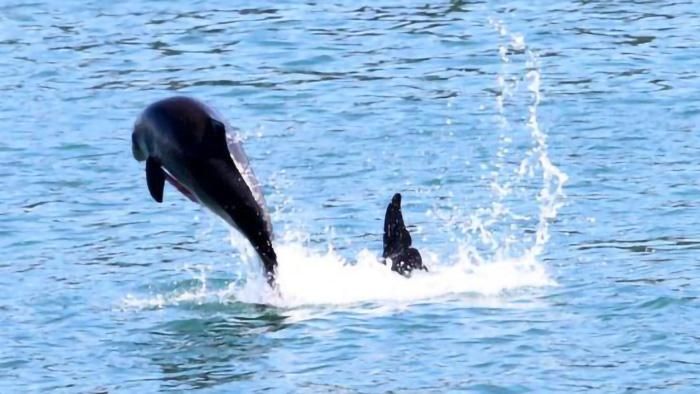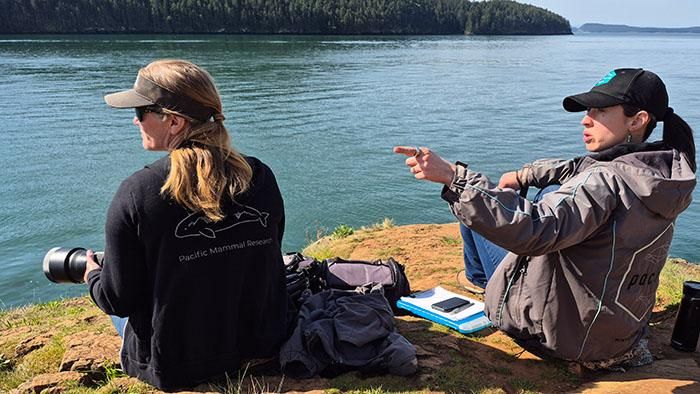by Richard Arlin Walker
Harbor porpoises are finding food and low risk in Burrows Pass, off northwest Fidalgo Island.
On their road to population recovery, harbor porpoises found a safe haven in Burrows Pass. There’s little chance of encountering an orca, their main predator. There’s minimal risk of getting entangled in a fishing net. There are no large ships to dodge.
And there’s food — more on that in a minute.
The harbor porpoise population is rebounding throughout the Salish Sea, according to the National Oceanic and Atmospheric Administration, after years of fishing-gear entanglements and habitat degradation that made the porpoises’ food sources scarce. NOAA estimated the Salish Sea harbor porpoise population was about 11,233 in 2016 — the latest estimate for the U.S. waters of the Salish Sea and an increase from 3,509 in 1996.
A subpopulation of those porpoises frequents Burrows Pass — a channel less than a mile long and a mile wide between Burrows Island and Anacortes’ Washington Park. Marine scientists at Pacific Mammal Research, or PacMam, have been studying harbor porpoises in the pass for 11 years.
Their research says a lot about the porpoises’ habits and the health of this immediate marine environment.
“They feed there, they mate there, they bring their calves there,” Elliser said. “We have individuals that we’ve repeatedly seen up to 11 years come to that particular area, so it’s obviously important for them.”

A harbor porpoise leaps during a mating attempt. (Cindy R. Elliser / Pacific Mammal Research)
Elliser said PacMam is still documenting the “why,” though there are clues. “I’m assuming that at least part of it is because it’s a good food source,” Elliser said. “Harbor porpoises can starve in as little as three days if they’re already not doing well, so they don’t have a large time frame to hunt for food. It must be that food sources are consistent here and the porpoises know they can come here and find something to eat.”
Kelp forests visible along the rugged coastline of Washington Park support sand lance, herring and smelt that porpoises like to eat. Auklets and harbor seals, which prefer the foods favored by porpoises, also frequent the pass. All told, the presence of porpoises and other animals in the pass “is really a good indicator for the health of this area,” Elliser said.
‘Know your neighbors’
It’s a sunny yet chilly April spring morning, and Elliser and White are settled in on a rocky outcropping overlooking the pass. Elliser photographs harbor porpoises and seals that come into view, while White records the data in a log and keeps watch for more sightings.
“It’s not a bad office,” White said as she scanned Burrows Bay. “It’s a beautiful spot to be.”
They’ve done this work here for two to four days a week, two hours a day, in sunshine, rain and snow, since 2014.
Both are marine scientists — Elliser earned her PhD in Integrative Biology at Florida Atlantic University and studied spotted and bottlenose dolphins in the Bahamas for the Wild Dolphin Project; White earned a master’s in Marine Mammal Research at University of St. Andrews in Scotland and did field research and photo-identification for the South Western Marine Research Program in Western Australia.
Elliser’s interest in harbor porpoises was piqued by annoyance and curiosity. It bothered her that she frequently heard people – including one of her teachers – call dolphins “porpoises” and porpoises “dolphins.” “It drove me nuts, because they’re not the same,” she said. “And so I was a big proponent about teaching people about the difference between the two.”
Knowing the difference could influence environmental policy as it pertains to the porpoise.
“It’s really important for people to know their neighbors, because you won’t protect something unless you know about it or care about it,” Elliser said. “And if we can protect the porpoises, that, in turn, helps protect the ecosystem, which protects other things.”
Elliser and White have authored or co-authored 12 peer-reviewed papers, published in marine science journals, about photo identification of harbor porpoises, group characteristics, sexual behavior and anatomy, the frequency of returns to Burrows Pass — called “site fidelity” — and how the porpoises’ feeding draws other animals such as bald eagles and harbor seals.

Pacific Mammal Research scientist Katrina White, right, points out a porpoise siting to fellow scientist Cindy Elliser on April 4 at Burrows Pass, Washington Park, Anacortes. (Richard Walker Arlin Walker / Salish Current)
Here’s what PacMam’s research tells us.
PacMam can identify each porpoise based on a unique physical characteristic.
“For most small cetaceans, like dolphins, you can identify them by their dorsal fins,” Elliser said. “They get nicks and notches in them. A harbor porpoise’s dorsal fin is smaller and for the most part it’s pretty clean. But a harbor porpoise’s body has countershading on it, where its back is darker than its belly, and the pigmentation patterns along that line between dark and light are unique for the individual.”
These unique markings enable PacMam to identify and monitor the Burrows Pass population. Other organizations have long used the same technique to identify and track other animal populations. The Center for Whale Research on San Juan Island uses photo identification to maintain a census of Southern Resident orcas for NOAA.
Harbor porpoises also likely have a limited range. DNA study of harbor porpoise populations in Alaska found that those groups were demographically and genetically distinct from others. “The calves stay in the area where they were born, they don’t move around, so they basically have these smaller subpopulations within this larger population,” Elliser said.
“I think that’s what we’ll end up seeing here in the Salish Sea. For example, we see Pointer” — a porpoise PacMam has identified and named — “year-round, all the time. It’s unlikely she’s gallivanting all the way up to B.C. and then coming back. So, I think we’re going to see these smaller communities within the Salish Sea. How genetically or socially distinct they are, that’s a different question. But I think there are other local populations, and we’d love to get more photos from people around the Salish Sea to be able to help document that.”
Harbor porpoises mostly hang in smaller groups. “Usually we see a single individual or two individuals or an individual with a mother and a calf,” Elliser said. “They don’t travel in groups in the same way that dolphins do.” But harbor porpoises are known to meet up with larger groups, “like big, giant parties where there are hundreds of porpoises,” Elliser said. “So they have a social structure. We just don’t know what that looks like yet.”
NOAA estimates the harbor porpoise lifespan at between eight to 24 years, “which basically means that we don’t know — that’s a really wide range,” Elliser said.
PacMam believes the age range is more mid-teens to 24 years because female porpoises reach sexual maturity at ages 3-4 but are still birthing calves at ages 10–14.
Porpoises can get airborne when mating. “The male comes up on the left hand side of the female and leaps at her and over, and then she cartwheels away,” Elliser said. “They jump up and do it real quick. They don’t always do it aerial, but they do it often enough.”
She added, “That’s the kind of stuff we have to know in order to know how they reproduce and how often they’re going to do it and what they need to do it. And the only way you find that out is by being out and observing the animals.”
PacMam’s steady presence at Burrows Pass has yielded other important information about the web of life. Sea otters are common to the outer coast, although they’ve been seen in the San Juan Islands. Elliser and White have observed a sea otter in Burrows Pass; sea otters eat urchins that live in kelp forests. And they’ve observed marbled murrelets, an endangered seabird whose principal foods include sand lance, herring and smelt.
An ounce of prevention
Elliser and White chose Burrows Pass because an earlier organization had studied the porpoise population there using underwater sound recording equipment and observation from land. Still, they said, there was so much that was unknown about the porpoises.
“I was particularly interested in whether we could ID individual porpoises and learn about their lives,” Elliser said. “My whole research in the past had been photo ID and tracking individuals and looking at their society. I was like, ‘I don’t think anybody’s done that with porpoises. Can you even do it?’ And that’s kind of what started it all.”
PacMam collaborates and shares data with marine scientists and naturalists from other organizations; its co-authors of research papers include representatives of the California Academy of Sciences, Cascadia Research Collective, Marine Mammal Center, Oregon State University, Pacific Whale Watch Association, Pierce College, Portland State University and Sea View Marine Sciences.
Elliser also is on the Marine Mammal Work Group of the Puget Sound Ecosystem Monitoring Project, which is related to the Puget Sound Partnership, a state agency. “The work group meets quarterly, and we update each other on research that we’re doing. So, the science is getting out to the people who make the policy decisions and regulations to be able to use it for good.”
Here’s what Elliser hopes the general public learns from the research conducted by PacMam and others:
“Right now, the harbor porpoise population is doing well, so they’re not as high on the priority list as other species,” Elliser said. “But it’s that ounce of prevention — can we make sure that there are regulations in place now so that we don’t have to go back and fix it?”
Harbor porpoises were considered the most common cetacean in the Salish Sea in the 1940s, according to the Washington State Department of Fish and Wildlife. Their population declined in the 1970s but rebounded in the early 2000s.
“We don’t know why the porpoises left, and we don’t know why they came back, because no one was watching them,” Elliser said. “Gill nets were being used; there was habitat destruction. Porpoises spend their whole lives a few miles from shore, so it’s likely a combination of factors made it difficult for them to live where they normally do. We’ve started making that better in a lot of ways, but we still have a long way to go.
“I would hope that the research we’re doing prevents population declines from happening again.
Republished with permission. Read the original article at salishcurrent.org.
